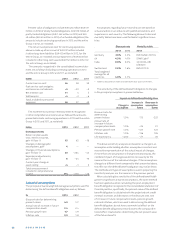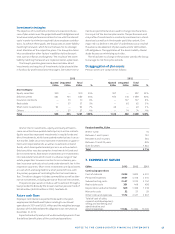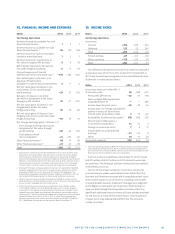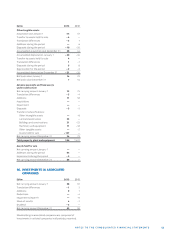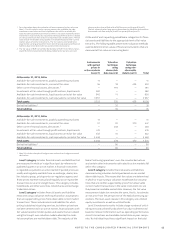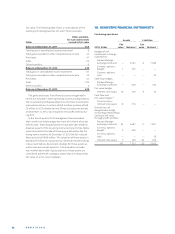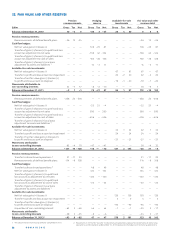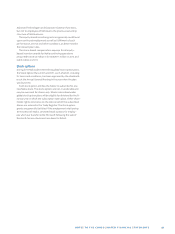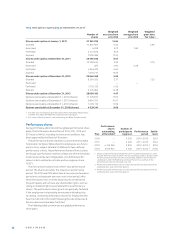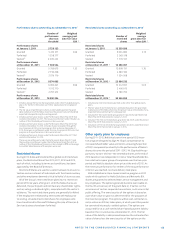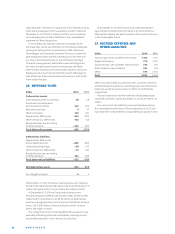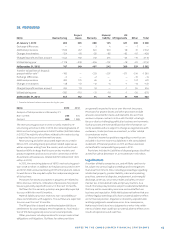Nokia 2013 Annual Report Download - page 57
Download and view the complete annual report
Please find page 57 of the 2013 Nokia annual report below. You can navigate through the pages in the report by either clicking on the pages listed below, or by using the keyword search tool below to find specific information within the annual report.
55
NOTES TO THE CONSOLIDATED FINANCIAL STATEMENTS
For information about the valuation of items measured at fair value see
Note . The fair value is set to carrying amount for available-for-sale
investments carried at cost less impairment for which no reliable fair
value has been possible to estimate as there is no active market for these
investments in private funds. Impairment testing of these assets is based
on a discounted cash flow analysis of expected cash distributions. The fair
value of loan receivables and payables is estimated based on the current
market values of similar instruments. The fair value is estimated to be
equal to the carrying amount for short-term financial assets and financial
liabilities due to limited credit risk and short time to maturity.
The fair value of EUR Convertible Bonds (total of EUR million matur-
ing -) is based on bonds being redeemed at par plus accrued
Instruments Valuation Valuation
withquoted technique technique
prices in using using non-
active markets observable observable
(Level 1) data (Level 2) data (Level 3) Total
At December31, 2013, EURm
Available-for-sale investments, publicly quoted equity shares 11 — — 11
Available-for-sale investments, carried at fair value 56 18 429 503
Other current fi nancial assets, derivatives 1 — 191 — 191
Investments at fair value through profi t and loss, liquid assets 382 — — 382
Available-for-sale investments, liquid assets carried at fair value 945 11 — 956
Available-for-sale investments, cash equivalents carried at fair value 3957 — — 3957
Total assets 5351 220 429 6000
Derivative liabilities 1 — 35 — 35
Total liabilities — 35 — 35
At December31, 2012, EURm
Available-for-sale investments, publicly quoted equity shares 11 — — 11
Available-for-sale investments, carried at fair value 57 20 370 447
Other current fi nancial assets, derivatives 1 — 448 — 448
Investments at fair value through profi t and loss, liquid assets 415 — — 415
Available-for-sale investments, liquid assets carried at fair value 532 10 — 542
Available-for-sale investments, cash equivalents carried at fair value 5448 — — 5448
Total assets 6463 478 370 7311
Derivative liabilities 1 — 90 — 90
Total liabilities — 90 — 90
interest at the close of Sale of the D&S business to Microsoft (level ).
The fair values of other long-term interest bearing liabilities are based on
discounted cash flow analysis (level ) or quoted prices (level).
At the end of each reporting period Nokia categorizes its fi nan-
cial assets and liabilities to the appropriate level of fair value
hierarchy. The following table presents the valuation methods
used to determine fair values of fi nancial instruments that are
measured at fair value on a recurring basis:
Note includes the split of hedge accounted and non-hedge accounted
derivatives.
Level category includes fi nancial assets and liabilities that
are measured in whole or in signifi cant part by reference to
published quotes in an active market. A fi nancial instrument
is regarded as quoted in an active market if quoted prices are
readily and regularly available from an exchange, dealer, bro-
ker, industry group, pricing service or regulatory agency and
those prices represent actual and regularly occurring market
transactions on an arm’s length basis. This category includes
listed bonds and other securities, listed shares and exchange
traded derivatives.
Level category includes fi nancial assets and liabilities
measured using a valuation technique based on assumptions
that are supported by prices from observable current market
transactions. These include assets and liabilities for which
pricing is obtained via pricing services, but where prices have
not been determined in an active market, fi nancial assets with
fair values based on broker quotes and assets that are valued
using the Group’s own valuation models whereby the mate-
rial assumptions are market observable. The majority of the
Nokia Continuing operations’ over-the-counter derivatives
and certain other instruments not traded in active markets fall
within this category.
Level category includes fi nancial assets and liabilities
measured using valuation techniques based on non market
observable inputs. This means that fair values are determined
in whole or in part using a valuation model based on assump-
tions that are neither supported by prices from observable
current market transactions in the same instrument nor are
they based on available market data. However, the fair value
measurement objective remains the same, that is, to estimate
an exit price from the perspective of the Nokia Continuing op-
erations. The main asset classes in this category are unlisted
equity investments as well as unlisted funds.
Level investments mainly include a large number of unlist-
ed equities and unlisted funds where fair value is determined
based on relevant information such as operating performance,
recent transactions and available market data on peer compa-
nies. No individual input has a signifi cant impact on the total



